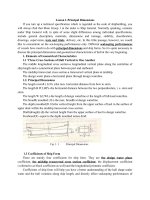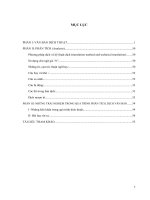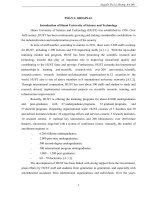KHÓA LUẬN TỐT NGHIỆP NGÀNH TIẾNG ANH A CONSIDERATION OF HAND GESTURE IN DIFFERENT CULTURES
Bạn đang xem bản rút gọn của tài liệu. Xem và tải ngay bản đầy đủ của tài liệu tại đây (1.47 MB, 62 trang )
THE MINISTRY OF EDUCATION AND TRAINING
HAI PHONG PRIVATE UNIVERSITY
FOREIGN LANGUAGE DEPARTMENT
INTERNSHIP REPORT
ISO 9001 : 2008
BỘ GIÁO DỤC VÀ ĐÀO TẠO
TRƯỜNG ĐẠI HỌC DÂN LẬP HẢI PHÒNG
KHÓA LUẬN TỐT NGHIỆP
NGÀNH: TIẾNG ANH
Sinh viên : La Quang Tiến
Giảng viên hướng dẫn: ThS. Nguyễn Thị Huyền
HẢI PHÒNG - 2014
ISO 9001 : 2008
BỘ GIÁO DỤC VÀ ĐÀO TẠO
TRƯỜNG ĐẠI HỌC DÂN LẬP HẢI PHÒNG
BỘ GIÁO DỤC VÀ ĐÀO TẠO
TRƯỜNG ĐẠI HỌC DÂN LẬP HẢI PHÒNG
GRADUATION PAPER
A CONSIDERATION OF HAND GESTURE IN
DIFFERENT CULTURES
KHÓA LUẬN TỐT NGHIỆP ĐẠI HỌC HỆ CHÍNH QUY
NGÀNH: TIẾNG ANH
Sinh viên : La Quang Tiến
Lớp : NA1401
Giảng viên hướng dẫn : ThS. Nguyễn Thị Huyền
HẢI PHÒNG - 2014
BỘ GIÁO DỤC VÀ ĐÀO TẠO
TRƯỜNG ĐẠI HỌC DÂN LẬP HẢI PHÒNG
NHIỆM VỤ ĐỀ TÀI TỐT NGHIỆP
Sinh viên: La Quang Tiến Mã SV:1012751011
Lớp: NA1401 Ngành: Tiếng Anh
Tên đề tài: A CONSIDERATION OF HAND GESTURE IN
DIFFERENT CULTURES
NHIỆM VỤ ĐỀ TÀI
1. Nội dung và các yêu cầu cần giải quyết trong nhiệm vụ đề tài tốt
nghiệp (về lý luận, thực tiễn, các số liệu cần tính toán và các bản vẽ).
2. Các số liệu cần thiết để thiết kế, tính toán.
3. Địa điểm thực tập tốt nghiệp.
CÁN BỘ HƯỚNG DẪN ĐỀ TÀI TỐT NGHIỆP
Người hướng dẫn thứ nhất:
Họ và tên: Nguyễn Thị Huyền
Học hàm học vị: Thạc sỹ
Cơ quan công tác: trường Đại học Dân lập Hải Phòng
Nội dung hướng dẫn: A CONSIDERATION OF HAND GESTURE IN
DIFFERENT CULTURES
Người hướng dẫn thứ hai:
Họ và tên:
Học hàm học vị:
Cơ quan công tác:
Nội dung hướng dẫn:
Đề tài tốt nghiệp được giao ngày 25 tháng 03 năm 2014
Yêu cầu phải hoàn thành trước ngày 29 tháng 06 năm 2014
Đã nhận nhiệm vụ ĐTTN Đã giao nhiệm vụ ĐTTN
Sinh viên Người hướng dẫn
Hải Phòng, ngày … tháng … năm 2014
Hiệu trưởng
GS.TS.NGƯT Trần Hữu Nghị
PHẦN NHẬN XÉT CỦA CÁN BỘ HƯỚNG DẪN
1. Tinh thần thái độ của sinh viên trong quá trình làm đề tài tốt
nghiệp:
2. Đánh giá chất lượng của khóa luận (so với nội dung yêu cầu đã để
ra trong nhiệm vụ Đ.T.T.N trên các mặt lý luận, thực tiễn, tính
toán số liệu…):
3. Cho điểm của cán bộ hướng dẫn (ghi bằng cả số và chữ):
Hải Phòng, ngày … tháng … năm 2014
Cán bộ hướng dẫn
(Ký và ghi rõ họ tên)
NHẬN XÉT ĐÁNH GIÁ CỦA NGƯỜI CHẤM PHẢN BIỆN ĐỀ TÀI
TỐT NGHIỆP
1. Đánh giá chất lượng đề tài tốt nghiệp về các măth thu thập và phân
tích tài liệu, số lieu ban đầu, giá trị lí luận và thực tiễn của đề tài.
………………………………………………………………………………
………………………………………………………………………………
………………………………………………………………………………
………………………………………………………………………………
………………………………………………………………………………
………………………………………………………………………………
………………………………………………………………………………
………………………………………………………………………………
………………………………………………………………………………
………………………………………………………………………………
2. Cho điểm của người chấm phản biện (ghi bằng cả số và chữ):
………………………………………………………………………………
Ngày … tháng … năm 2014
Người chấm phản biện
(Ký và ghi rõ họ tên)
TABLE OF CONTENT
PART I: INTRODUCTION 1
1. Rationale 1
2. Aims of the Study 2
3. Research Questions 3
4. Scope of the Study 3
5. Design of the Study 3
PART II: DEVELOPMENT 5
CHAPTER 1: LITERATURE REVIEW 5
1.1 Introduction: 5
1.2 Verbal vs Non-verbal Communication 5
1.3 Verbal Communication 6
1.3.1 What is verbal communication? 6
1.3.2 Types of verbal communication 6
1.3.3 Features of effective verbal communication 7
1.3.3.1 Clarity 7
1.3.3.2 Summaries 7
1.3.3.3 Observe Responses 7
1.3.3.4 Background Noise 7
1.3.3.5 Use of Voice 7
1.3.3.6 Eye Contact 7
1.3.3.7 Undivided Attention 8
1.3.3.8 Emphasize Important Points 8
1.3.3.9 Positivity 8
1.3.3.10 Choose your words 8
1.4 Non-Verbal communication 8
1.4.1 What is non- verbal communication? 8
1.4.2 Types of non-verbal communication 9
1.4.2 .1 Facial expressions 9
1.4.2.2 Body movements and posture 10
1.4.2.3 Gestures 10
1.4.2.4 Eye contact 10
1.4.2.5 Touch 10
1.4.2.6 Space 10
1.4.2.7 Voice 11
1.4.3 Features of effective non-verbal communication 11
1.4.4 How non-verbal communication signals affect verbal discourse 12
1.4.5 Cross-cultural non-verbal communication 13
1.5 Hand gesture 15
1.5.1 What are hand gestures? 15
1.5.2 Roles of hand gestures in communication 15
1.5.3 Benefit and Limitations of hand gestures 17
1.5.3.1 The Benefits 17
1.5.3.1.1 Reinforcing Verbal Communication 17
1.5.3.1.2 Feedback 17
1.5.3.1.3 Self-Expression 18
1.5.3.2 The Limitation 18
1.5.3.2.1 Imprecise and Easily Misread 18
1.5.3.2.2 Limited Distance 18
1.5.3.2.3 Lacking Complexity 19
1.5.4 Conclusion 19
CHAPTER 2: A CROSS-CULTURAL STUDY ON HAND GESTURES 20
2.1 Types of Hand Gesture 20
2.1.1 Iconic 21
2.1.2 Beat 21
2.1.3 Deictic 22
2.1.4 Metaphoric 22
2.1.5 Emblems 22
2.1.6 Regulators 23
2.1.7 Affect displays 23
2.2 Cross-Cultural Differences of Hand Gesture 23
2.2.1 V-sign 25
2.2.2 Thumb up 25
2.2.3 Thumb down 25
2.2.4 Crossing finger 26
2.2.5 Palm facing towards 26
2.2.6 Index finger down 26
2.2.7 Palm Stretch 27
2.2.8 Dog call 27
2.2.9 Ok sign 27
2.2.10 Snapping fingers 28
2.2.11 Wrist watch 28
2.2.12 Pointing finger 28
2.2.13 Corona 29
2.2.14 Fig 29
2.2.15 Chin flick 30
2.2.17 Moutza 30
2.2.18 Five father 30
2.2.19 Pepper mill 31
2.2.20 Corna 31
2.2.21 Write-off 31
2.2.22 Cutis 31
2.2.23 Tacano 32
2.2.24 Fishy smell 32
2.2.25 What is the time? 32
2.2.26 Holding 3 fingers 32
2.2.27 Holding forefinger 33
2.2.28 Burgers 33
2.2.29 Hold hands 33
2.2.30 F*ck you 34
CHAPTER 3: CULTURE SHOCKS CAUSED BY HAND GESTURE AND
SUGGESTION TO AVOID 35
3.1 Culture Shocks: 35
3.2 Culture shocks caused by Hand gestures 36
3.3 Suggestion to avoid culture shock caused by hand gesture 39
PART III: CONCLUSION 44
1. Overview of the study 44
2. Limitations and suggestion for further study 44
Acknowledgement
In the process of doing the graduation paper, I have received a lot of help,
assistance, guidance and encouragement from my teacher, family and friends.
First and foremost, I would like to express my deepest gratitude to my
supervisor Ms. Nguyen Thi Hien M.A, lecture of Faculty of Foreign
Languages of Hai Phong Private University, for her whole-hearted guidance
and support. Without her invaluable recommendations and advices, I could
not finish this thesis
My sincere thanks are also sent to all the teacher of English Department at
Hai Phong Private University for their precious and useful lessons during my
four-year study which have been then the foundation of this research paper.
Last but not lest, I would like to give my heartfelt thanks to my family, my
friends who always, encourage and inspirit me to complete this graduation
paper.
Hai Phong, June, 2014
La Quang Tien
1
PART I: INTRODUCTION
Language can shape how we see, taste, smell, feel, and hear. It also influences
the way we think about the people, ideas, and objects around us. Language
communicates a culture‘s most important norms, values, and sanctions.
Besides with verbal language, we also get used to nonverbal language (body
language) such as eye contact, hand gesture, posture and so on. We are not
born with these expressions. We learn them, just as we learn other forms of
language, from people who share our same culture Have you ever asked
yourself why you‘re speaking in front of a group and then you suddenly
become aware of these great clumsy appendages at the end of your arms –
your hands? Why do you suddenly wonder what to do about them? The
answer is when people talk, they often gesture with their hands. To get deeper
and deeper in understanding this problem, in this very first part, I would like
to demonstrate the Rationale, Aim of the study, Research questions, Scope of
the study, and Design of the study in Hand gestures which my study focus on.
1. Rationale
Human gesture is most naturally expressed with body and hands, ranging
from the simple gestures we use in normal conversations to the more
elaborate gestures used by baseball coaches giving signals to players; soldiers
gesturing for tactical tasks; and police giving body and hand signals to drivers.
Current technology for gesture understanding is, however, still sharply limited,
with body and hand signals typically considered separately, restricting the
expressiveness of the gesture vocabulary and making interaction less natural.
Hand gestures are a way of communicating with others and conveying your
feelings. These gestures are most helpful when one is speaking to someone
with no language in common. The meanings of hand gestures in different
cultures may be translated into different things.
2
Imagine a person doing a presentation without the hand gesture, he/she just
stands there and talk, imagine how hard is it to stay focus on what ever he‘s
saying even how interesting his presentation is but however overly use of
hand gesture can be so annoying. Gestures are body action The appropriate
use of hand gestures gives a speaker confidence and let him/herself express
his/her emotions effectively and clearly, this also gets the listeners attention
and help speaker describe or elaborate his topic. This is the importance of
hand gestures in communication.
But there are also danger in hand gestures, aside from that overly use of hand
gesture could be so annoying, hand gestures could mean something else in
other countries, as we learned in the beginning of our business
communication course that there are cultural barriers, and gesture is one of
those, we have to be really careful in using hand gestures in other countries
and cultures, we can offend our audience.
Also, for me – a student in major of foreign language. I myself could easily
feel how many advantages what hand gestures can help me to demonstrate my
point of view while talking more effetely. Moreover, hand gestures save my
life many times when I don‘t know how to explain what I would like to point
out for the foreigner…However, sometimes I made them get angry just
because different cultures have different hand gesture‘s meaning for a little of
constant samples. This encourages me to study the hand gestures, not in one
country but in a number of cultures. All the above reasons have inspired me to
choose the thesis entitled ―A consideration of hand gesture in different
cultures‖ to do research.
2. Aims of the Study
The study gears its object to:
I would like to show the study of the messages conveyed via hand gestures in
different culture, also to show differences and similarities of gesture in
3
different culture. Moreover, I will give out some suggestions for hand
gestures should be avoided in going abroad for Vietnamese.
3. Research Questions
The study is conducted to answer the following questions: How are hand
gestures different in different cultures? What way to help people bare in mind
when communicating to each others by hand gesture properly?
4. Scope of the Study
Hand gestures are a big theme; however, because of the limited time and my
knowledge, in this paper, I only focus on the several common types of hand
gesture signs which are Iconic, Beat, Deictic, Metaphoric, Emblems,
Regulators and Affect Displays. I‘ll point out the benefit which anyone can
gain while using hand gestures to communicate with another or in group, also
the limitations of these gestures. From these above explanation, I‘d like to list
the most common forms you can deal with whilst going on a tour outside of
Viet Nam, the difference and the similar of them based on each culture.
Finally, I‘ll give some evidences of culture shock which used to occur in the
past caused by misunderstanding concept on specific hand gesture among the
native in various cultures and some suggestions to avoid it.
5. Design of the Study
The study is divided into three parts:
Part I: Introduction presents the rationales, aims, research questions, scope,
method and design of the study.
Part II: Development consists of three chapters
Chapter 1: Literature review - Explains the difference between verbal &
nonverbal communication and deals with the concepts, history, and the roles
of hand gestures in communication. To deal with the difference between
verbal communication and nonverbal communication, which is consisted of
Verbal Communication, The Written Word, Gestures, and Body Language
4
and give out the Concept of hand gestures and Role of hand gestures in
communication.
Chapter 2: A cross-cultural study on hand gestures - gives the type‘s analysis,
subjects, data collection. Also, point out the good points and the limitations of
these researches. To show the Types of hand gesture are Iconic, Beat, Deictic,
Metaphoric, Emblems, Regulators and Affect displays Also, in this part will
point out the Benefits of hand gesture are Reinforcing verbal communication,
Feedback, Self-Expression, and the Limitations are Imprecise and easily
misread, Limited Distance, Lacking Complexity. Moreover, I will show the
Cross-cultural communication of hand gesture - In this chapter, I‘d explain
detail to Cross-cultural differences in hand gesture - shows the results of
comprehensive analysis on the data collected about the most common hand
gestures in different culture.
Chapter 3: Culture shocks caused by hand gesture and suggestion to
overcome. In this chapter, I will explain the definition of culture shock,
symptoms and its stages. Also, some examples of culture chock caused by
hand gesture will be given out. Finally, I would like to give some suggestion
to avoid these situations.
Part III: Conclusion
Conclusion for an overview of the study. The important of verbal and
nonverbal communication, the definition, features and its types. Refer to hand
gestures, its roles in communication, types, benefits and limitations. Based on
it, I present a study on cross-culture of hand gesture. Finally, I aim at culture
shock caused by hand gesture definition, symptoms, stages and examples to
help you avoid these troubles with a lot of suggestions and some taboo hand
gestures in various countries.
5
PART II: DEVELOPMENT
CHAPTER 1: LITERATURE REVIEW
1.1 Introduction:
Hand gestures are a way of communicating with others and conveying your
feelings. These gestures are most helpful when one is speaking to someone
with no language in common. The meanings of hand gestures in different
cultures may be translated into different things. But there are also danger in
hand gestures, aside from that overly use of hand gesture could be so
annoying, hand gestures could mean something else in other countries, as we
learned in the beginning of our business communication course that there are
cultural barriers, and gesture is one of those, we have to be really careful in
using hand gestures in other countries and cultures, we can offend our
audience. This encourages me to study the hand gestures, not in one country
but in a number of cultures. All the above reasons have inspired me to choose
the thesis entitled ―A consideration of hand gesture in different cultures‖
to do research.
1.2 Verbal vs Non-verbal Communication
Communication is the activity of conveying information through the
exchange of ideas, feelings, intentions, attitudes, expectations, perceptions or
commands, as by speech, gestures, writings, behavior and possibly by other
means such as electromagnetic, chemical or physical phenomena. It is the
meaningful exchange of information between two or more participants
(machines, organisms or their parts). Communication requires a sender,
a message, a medium and a recipient, although the receiver does not have to
be present or aware of the sender's intent to communicate at the time of
communication; thus communication can occur across vast distances in time
and space. Communication requires that the communicating parties share an
6
area of communicative commonality. The communication process is complete
once the receiver understands the sender's message
Communicating with others involves three primary components: Verbal
Messages, Paraverbal Messages and Non-verbal Messages
1.3 Verbal Communication
1.3.1 What is verbal communication?
As for Business Dictionary: A medium for communication that entails talking
using the spoken word, such as talking face-to-face, on a telephone, or as a
speech.
As for Tooling University: The sharing of information between individuals by
using speech. Individuals working within a business need to effectively use
verbal communication that employs readily understood spoken words, as well
as ensuring that the enunciation, stress and tone of voice with which the
words are expressed is appropriate.
To conclude, verbal communication refers to the use of sounds and language
to relay a message. It serves as a vehicle for expressing desires, ideas and
concepts and is vital to the processes of learning and teaching. In combination
with nonverbal forms of communication, verbal communication acts as the
primary tool for expression between two or more people.
1.3.2 Types of verbal communication
There are two different types of verbal communication, oral and written
communication. Oral communication is when somebody uses spoken words
to communicate with whom they are trying to convey something to. This can
be done either in person or over the phone. Written communication is when
somebody writes down what they intend to say, this can be done via letter, e-
mail, text message or any other electronic documents. Written communication
has become more popular in the last decade than oral communication.
7
1.3.3 Features of effective verbal communication
1.3.3.1 Clarity
Be as clear and as specific as possible in all verbal communications and
especially when you are asking someone to carry out a task for you.
1.3.3.2 Summaries
If you are not sure that people understand you, either summaries what you
have said in different words, or ask them to summaries your message in their
own words.
1.3.3.3 Observe Responses
Observe response to your message. What people are thinking is not always
expressed verbally. Read people‘s thoughts by watching their facial
expressions, hand and foot gestures. Look at their eyes for signs of confusion,
disagreement, disbelief, resistance or understanding.
1.3.3.4 Background Noise
If there is background noise, speak loudly or move to a quieter
area. Reinforce verbal communication, especially in noisy areas, with
gestures.
1.3.3.5 Use of Voice
To keep people‘s attention, modulate your voice. Speaking more loudly or
softly, more quickly or slowly increases interest in what you say. Pause before
and after a key point to allow it to fully register.
1.3.3.6 Eye Contact
Maintain eye contact with those to whom you are talking. Bear in mind their
cultural background. In some cultures, excessive eye contact is a sign of
disrespect.
8
1.3.3.7 Undivided Attention
Pay attention. Avoid interruptions. Don‘t hold two conversations at the same
time.
1.3.3.8 Emphasize Important Points
To communicate an important point, raise your voice slightly or speak
deliberately. Let your body language reflect the importance of what you are
saying by leaning forward, opening your eyes wider, and using appropriate
hand gestures.
1.3.3.9 Positivity
Begin conversations positively. If there is potential for conflict, start off with
something on which you both agree to set a positive atmosphere.
1.3.3.10 Choose your words
Avoid using ‗but‘ to join sentences, ―But‖ puts people on the defensive. Use
‗and‘ to join sentences, it is far more positive. And where possible, use ‗I‘
messages. Using ‗you‘ makes people defensive.
1.4 Non-Verbal communication
1.4.1 What is non- verbal communication?
Nonverbal communication involves those nonverbal stimuli in a
communication setting that are generated by both the source [speaker] and his
or her use of the environment and that have potential message value for the
source or receiver [listener] (Samovar et al). Basically it is sending and
receiving messages in a variety of ways without the use of verbal codes
(words). It is both intentional and unintentional. Most speakers / listeners are
not conscious of this.
In short, nonverbal communication is the process of communication through
sending and receiving wordless (mostly visual) cues between people. It is
sometimes mistakenly referred to as body language but nonverbal
9
communication encompasses much more, such as use of voice, touch,
distance and physical environments/appearance. Typically overlooked in
nonverbal communication are polemics, or the informal space around the
body and chromatics: the use of time. Not only considered eye
contact, coalesces comprises the actions of looking while talking and listening,
frequency of glances, patterns of fixation, pupil dilation, and blink rate.
1.4.2 Types of non-verbal communication
There are many different types of nonverbal communication. Together, the
following nonverbal signals and cues communicate your interest and
investment in others.
Figure 1: Types of Nonverbal Communication: Notes on the Visual Perception of Human
Relations, 1956.
1.4.2 .1 Facial expressions
The human face is extremely expressive, able to express countless emotions
without saying a word. And unlike some forms of nonverbal communication,
facial expressions are universal. The facial expressions for happiness, sadness,
anger, surprise, fear, and disgust are the same across cultures.
10
1.4.2.2 Body movements and posture
Consider how your perceptions of people are affected by the way they sit,
walk, stand up, or hold their head. The way you move and carry yourself
communicates a wealth of information to the world. This type of nonverbal
communication includes your posture, bearing, stance, and subtle movements.
1.4.2.3 Gestures
Gestures are woven into the fabric of our daily lives. We wave, point, beckon,
and use our hands when we‘re arguing or speaking animatedly—expressing
ourselves with gestures often without thinking. However, the meaning of
gestures can be very different across cultures and regions, so it‘s important to
be careful to avoid misinterpretation.
1.4.2.4 Eye contact
Since the visual sense is dominant for most people, eye contact is an
especially important type of nonverbal communication. The way you look at
someone can communicate many things, including interest, affection, hostility,
or attraction. Eye contact is also important in maintaining the flow of
conversation and for gauging the other person‘s response.
1.4.2.5 Touch
We communicate a great deal through touch. Think about the messages given
by the following: a weak handshake, a timid tap on the shoulder, a warm bear
hug, a reassuring slap on the back, a patronizing pat on the head, or a
controlling grip on your arm.
1.4.2.6 Space
Have you ever felt uncomfortable during a conversation because the other
person was standing too close and invading your space? We all have a need
for physical space, although that need differs depending on the culture, the
situation, and the closeness of the relationship. You can use physical space to
11
communicate many different nonverbal messages, including signals of
intimacy and affection, aggression or dominance.
1.4.2.7 Voice
It‘s not just what you say, it‘s how you say it. When we speak, other people
―read‖ our voices in addition to listening to our words. Things they pay
attention to include your timing and pace, how loud you speak, your tone and
inflection, and sounds that convey understanding, such as ―ahh‖ and ―uh-huh.‖
Think about how someone's tone of voice, for example, can indicate sarcasm,
anger, affection, or confidence.
1.4.3 Features of effective non-verbal communication
As for Floyd Pg in the book named ―Characteristics and Types of Nonverbal
Communication‖ published in 2011: There are five characteristics of
nonverbal communication that help explain why it is so important in our daily
lives
Firstly, Nonverbal communication is present in most interpersonal
conversations, including cyberspace communication with the use of
emoticons.
Secondly, Nonverbal communication often conveys more information than
verbal communication. It is possible that up to 93% of what we say is
translated by nonverbal clues. However, it is more realistic that only 65-70%
of translation is due to nonverbal communication. (That is still a lot higher
than I would have ever thought!)
Thirdly, Nonverbal communication is usually believed over verbal
communication. This could be due to the fact that it is harder to hide or fake
our nonverbal clues such as our facial expressions.
Fourthly, Nonverbal communication is the primary means of communicating
emotion. Think of what someone's facial expressions look like when they are
12
overjoyed or extremely sad. You can usually tell how they are feeling without
them saying a word.
Fifthly, Nonverbal communication is Meta communicative, for example, a
wink for sarcasm or covering our mouth with our hand to indicate we are
telling a secret.
1.4.4 How non-verbal communication signals affect verbal discourse
Psychologists Paul Ekman and Wallace Friesen (1969), in discussing the
interdependence that exists between nonverbal and verbal messages,
identified six important ways that nonverbal communication directly affects
our verbal discourse". First, we can use nonverbal signals to emphasize our
words. All good speakers know how to do this with forceful gestures, changes
in vocal volume or speech rate, deliberate pauses, and so forth… "Second, our
nonverbal behavior can repeat what we say. We can say yes to someone while
nodding our head. "Third, nonverbal signals can substitute for words. Often,
there isn't much need to put things in words. A simple gesture can suffice (e.g.,
shaking your head to say no, using the thumbs-up sign to say 'Nice job,'
etc.)…"Fourth, we can use nonverbal signals to regulate speech. Called turn-
taking signals, these gestures and vocalizations make it possible for us to
alternate the conversational roles of speaking and listening. "Fifth, nonverbal
messages sometimes contradict what we say. A friend tells us she had a great
time at the beach, but we're not sure because her voice is flat and her face
lacks emotion. . . .
AS for Martin S. Redland‘s definition in the book named ―Nonverbal
Communication in Everyday Life‖, 2nd ed. Houghton Mifflin in 2004: Finally,
we can use nonverbal signals to complement the verbal content of our
message. . . . Being upset could mean we feel angry, depressed, disappointed,
or just a bit on edge. Nonverbal signals can help to clarify the words we use
and reveal the true nature of our feelings.
13
1.4.5 Cross-cultural non-verbal communication
Nonverbal communication is hugely important in any interaction with others;
its importance is multiplied across cultures. This is because we tend to look
for nonverbal cues when verbal messages are unclear or ambiguous, as they
are more likely to be across cultures (especially when different languages are
being used). Since nonverbal behavior arises from our cultural common sense
our ideas about what is appropriate, normal, and effective as communication
in relationships we use different systems of understanding gestures, posture,
silence, spatial relations, emotional expression, touch, physical appearance,
and other nonverbal cues. Cultures also attribute different degrees of
importance to verbal and nonverbal behavior.
Some elements of nonverbal communication are consistent across cultures.
For example, research has shown that the emotions of enjoyment, anger, fear,
sadness, disgust, and surprise are expressed in similar ways by people around
the world. Differences surface with respect to which emotions are acceptable
to display in various cultural settings, and by whom. For instance, it may be
more social acceptable in some settings in the United States for women to
show fear, but not anger, and for men to display anger, but not fear. At the
same time, interpretation of facial expressions across cultures is difficult. In
China and Japan, for example, a facial expression that would be recognized
around the world as conveying happiness may actually express anger or mask
sadness, both of which are unacceptable to show overtly.
These differences of interpretation may lead to conflict, or escalate existing
conflict. Suppose a Japanese person is explaining her absence from
negotiations due to a death in her family. She may do so with a smile, based
on her cultural belief that it is not appropriate to inflict the pain of grief on
others. For a Westerner who understands smiles to mean friendliness and
happiness, this smile may seem incongruous and even cold, under the
circumstances. Even though some facial expressions may be similar across









